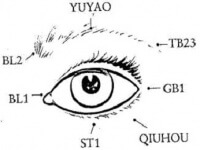
According to Traditional Chinese Medicine (TCM), all diseases involving the eye are closely related to the liver. It is also understood that the eye is nourished by all of the internal organs in the body. The lens of the eye and the pupil basically belong to the kidney, the sclera to the lungs, the arteries and veins to the heart, the top eyelid to the spleen, the bottom eyelid to the stomach, and the cornea and iris to the liver. The spleen and stomach also control circulation in the eyes. Therefore an imbalance in any of the internal organs may lead to eye disease.
Major Acupressure Eye Points
There are a number of acupuncture/acupressure points around the eyes (basically around the orbits of the eyes which are the bones that surround the eyeballs). The points shown above are some of the major local eye points.
- Jing ming (UB-1) lies where the inner corner of the eye meets the nose. Bladder 1 and 2 are perhaps the best two points for eye problems of all kinds from early-stage cataracts or glaucoma to hysteria with vision loss. They are also used for problems with conjunctivitis due to Wind-Heat and Liver Heat, to blurred vision in the elderly due to Deficient Jing and Blood
- Zan zhu (UB-2) lies in the depressions at the inner ends of the eyebrows. Bladder 1 and 2 are perhaps the best two points for eye problems of all kinds from early-stage cataracts or glaucoma to hysteria with vision loss. They are also used for problems with conjunctivitis due to Wind-Heat and Liver Heat, to blurred vision in the elderly due to Deficient Jing and Blood
- Yu yao is the midpoint of the eyebrow in the hollow. Good for eye problems related to worry, excessive study and mental strain.
- Si zhu kong (SJ 23) lies in the depression at the outside end of the eyebrow. This is a local point good for eye and facial problems, whether due to Wind invasion or the Liver Yang and Fire.
- Tong zi liao (GB 1) lies in the cavities on the outside corners of the eye sockets. Good for eye problems including conjunctivitis, red sore eyes, photophobia, dry, itchy eyes, early-stage cataracts and blurred vision, as well as lateral headaches.
- Qiu hou is found midway between St-1 and GB-1 along the orbit of the eyes.
- Cheng qi (St 1) is found directly blow the pupil on the infraorbital ridge bone. This is a main point for all eye problems, including those due to Wind Cold, Wind Heat and Hyperactive Liver Yang.
Self-Acupressure for Eye Health:
GENTLY massage each acupuncture point around the orbit of the eye, starting with B1-1 and massaging each point as you go up and outward. Each point should be massaged for approximately 5-10 seconds. You can massage both eyes at the same time. You can do this massage as often as you like over the course of the day. You may find that each point feels different in terms of sensitivity.
Keep BREATHING as you massage. Deep breathing helps the cells of your eyes receive the oxygen they need for healing. Practice long, slow abdominal breathing while massaging the acupressure points.
CAUTION: If you are pregnant, consult a trained acupuncturist before treating yourself. Do not massage on an area if it has a scar, burn or infection.
Self Help
Since most eye conditions are a reflection of the health of the whole body, lifestyle choices and diet can play a major factor in getting and maintaining good vision. Below are some recommendations:
- The Vision Diet – Studies show patients can reduce their eye pressure by five to seven millimeters with an improved diet and supplement program. In general, a diet high in betacarotene, vitamins C and E and sulfur-bearing amino acids are recommended. Foods containing those nutrients include garlic, onions, beans, spinach, celery, turnips, yellow and orange vegetables, green leafy vegetables, seaweed, apples, oranges and tomatoes.
- Daily Juicing (organic if possible) – 1 pint per day minimum. Up to 2-8 pints per day for healing. Vegetables used should be mostly greens.
- Drink lots of water – 8-10 glasses of purified water. Avoid carbonated, caffeinated and alcoholic beverages. They can actually dehydrate your eyes.
- Manage your stress – meditate, take a walk in nature, practice yoga, visualization techniques or prayer on a daily basis.
- Exercise daily – do at least 20 minutes of aerobic exercise daily. Walking and swimming are two excellent forms of exercise.
- Eye exercises can help to bring energy and blood to the eyes, thereby helping to drain away toxins or congestion to the eyes.
- Avoid foods to which you are allergic: a study of 113 patients with chronic simple glaucoma showed immediate IOP increases of up to 20 millimeters when they were exposed to foods in to which they were allergic.

